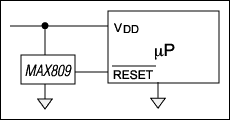检测电路保持您的微处理器控制-Supervisory Cir
[09-13 17:05:09] 来源:http://www.88dzw.com 控制技术 阅读:8332次
文章摘要:We haven't yet considered hysteresis. The above analysis shows that the rising-edge threshold fits our specification. The falling-edge threshold will be lower, however. Hysteresis for all these detectors is 5% typical and 7% or 8% maximum. The rising-edge threshold in our example is within the r
检测电路保持您的微处理器控制-Supervisory Cir,标签:计算机控制技术,工厂电气控制技术,http://www.88dzw.comWe haven't yet considered hysteresis. The above analysis shows that the rising-edge threshold fits our specification. The falling-edge threshold will be lower, however. Hysteresis for all these detectors is 5% typical and 7% or 8% maximum. The rising-edge threshold in our example is within the required range (4.5V to 4.75V), but the falling-edge threshold can be as low as 4.13V. That is, we cannot guarantee brownout detection until the supply voltage is almost 0.4V out of spec!
Electronic Procrastination Is the Answer
To prevent oscillatory behavior at the detection threshold without resorting to excessive hysteresis, we must delay the trailing edge of the reset pulse. As in the RC circuit described above, the reset pulse must hold for an interval after the supply voltage crosses the detector's threshold. This interval is called "delay time" or the "reset active-timeout period." Unlike the RC circuit delay, however, this one triggers when supply voltage crosses a precisely trimmed threshold in the detector. The delay should also be retriggerable to prevent oscillation in the µP's reset signal. When a slowly rising supply voltage causes multiple trigger events at the detector threshold, each event should re-start the timeout.Devices offering this basic function have been around for a long time, and in recent years have become available in the tiny, three-terminal SOT23 package. The first SOT23 device (MAX809) has become a much-copied industry standard. The generic 809 is available with several factory-trimmed reset thresholds, and it offers a guaranteed accuracy of ±2.6% over the -40°C to +85°C range. The 809 also guarantees a minimum active-timeout reset period of 140ms. It provides all the features described above and is much simpler than discrete-component approaches. Figure 3 illustrates the simplicity of an 809 circuit.

Figure 3. A three-terminal supervisory IC combines voltage monitoring (startup and brownout) with reset-delay capability.
The MAX809 draws as much as 60µA. Some recent clones of this part, including IMP's IMP809 and ETC's ETC809, feature maximum supply currents in the 15µA to 20µA range. The new MAX6326 and MAX6346 families, however, provide the same functionality with much lower supply currents. They draw 1µA maximum (0.5µA typical) for threshold voltages below 3.2V and 1.75µA maximum (1µA typical) for higher threshold voltages.
When Power-Supply Monitoring Is Not Enough
Three-terminal supervisors provide the primary supervisory function, but many applications require more of the supervisor. A basic function often needed is pushbutton or manual-reset input. This capability lets you initiate resets with a momentary pushbutton switch. It can also gate multiple binary signals or another reset to the µP's reset input. This input is debounced with the same delay function used in the power-supply monitor. The enhanced supervisor requires a fourth pin, which is provided by the SOT-143 (a four-pin SOT-23). Most manufacturers of the three-terminal devices mentioned above also make four-terminal devices that include this feature.上一页 [1] [2] [3] [4] [5] [6] [7] [8] 下一页
Tag:控制技术,计算机控制技术,工厂电气控制技术,控制技术
《检测电路保持您的微处理器控制-Supervisory Cir》相关文章
- › 恒流源供电和摘机检测电路图
- › 低功耗窗口温度检测电路图
- › 过零检测电路图
- › 电压输出式角度检测电路图
- › 电压检测电路图
- › 遥控红外检测电路图
- 在百度中搜索相关文章:检测电路保持您的微处理器控制-Supervisory Cir
- 在谷歌中搜索相关文章:检测电路保持您的微处理器控制-Supervisory Cir
- 在soso中搜索相关文章:检测电路保持您的微处理器控制-Supervisory Cir
- 在搜狗中搜索相关文章:检测电路保持您的微处理器控制-Supervisory Cir
分类导航
最新更新




 当前位置:
当前位置: